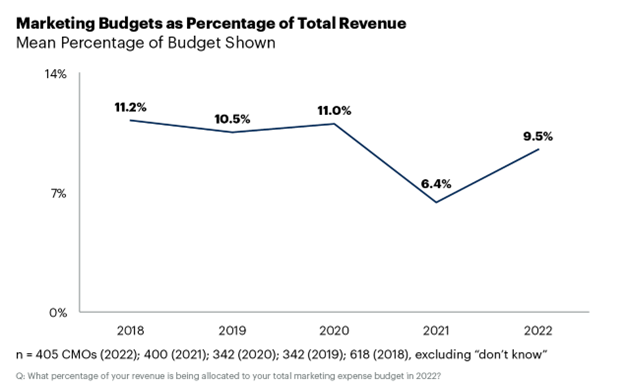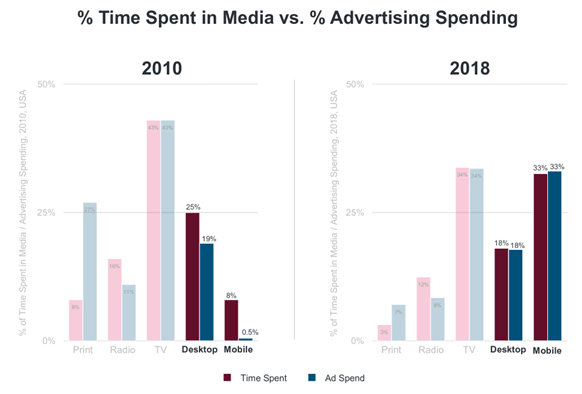Now that a recession is looming in America and most of the world, firms large and small are bracing for some lean years after a couple of fat years following the pandemic lockdowns.
People are especially price-sensitive during a recession, so raising prices seems out of the question. Firms will likely resort to cost-cutting, and much of those cuts will affect marketing budgets, which had been dwindling in many companies even before the pandemic arrived.
Though the marketing budget as a percentage of total revenue has increased substantially since it hit a low in 2021, by 2022 it had yet to catch up to pre-pandemic levels, data from Gartner found.

Source: Gartner
As firms consider squeezing their marketing budgets, it's crucial to understand the most effective methods relative to the total amount spent so that marketers can make informed and rational decisions that will maximize their return on investment.
There's a noticeable tendency among business owners and marketers to just throw all and sundry at advertising walls (i.e. platforms) and hope that something sticks. That is a wasteful and inefficient strategy, and luck decides the outcome. Your company should not toss a coin and hope it gets heads; it should choose heads for itself.
Advantages of Digital Advertising
Digital advertising has been growing by 15% annually since 2010, and it is projected to keep growing for years to come. It's no surprise that digital has become the main method of advertising and the number one go-to choice for small firms with a low marketing budget.

Source: IAB / PWC Internet Advertising Report
Digital advertising is affordable, measurable, and effective. Such advantages are crucial particularly for small businesses and firms that do not have large advertising budgets. Metrics such as clickthrough rate (CTR) allow tracking of the active response to the advertising and indicate cost per conversion (CPC), therefore enabling a much better comparison of campaign efficiency compared with traditional advertising.
Let's dive deeper into the various advantages of digital advertising.
1. The Ability to Solve (And Pay) for Different Goals
Digital advertising gives firms and marketers the ability to tailor their advertising according to the objective they want to achieve. If the goal is to grow brand awareness, they can cast the net wider for maximum impact. If, on the other hand, the goal is to increase sales, the ad can be served only to potential paying customers—i.e., people who have shown an interest and can afford to buy.
2. Smaller Budget Requirements
Companies don't need a large marketing budget to run a digital advertising campaign. It can be done with a small budget and scaled up or down. And because the digital world isn't limited by space, the reach of an advertisement with a small budget has the potential to rival that of one with a huge budget.
3. A/B Testing of Creative
Digital advertising makes it easy to understand customers' preferences. Marketers can A/B-test different campaigns and figure out which one works best for a specific audience and which clicks with potential customers. Campaigns that work can then be reinforced, whereas those that don't work as well can be trimmed or discontinued.
4. Sharper Segmentation and Personalized Targeting
A digital ad is less likely to go to waste or reach a nontarget audience. Digital advertising allows the ad to be customized and personalized to a specific demographic, narrowing the target range and increasing the chances of conversion.
5. Pay per Performance
Using the pay-for-performance model, marketers don't even need to understand the ins and outs of digital advertising. They can just pay the advertising platform based on the performance of the ad as defined and agreed upon before beginning the campaign. That way they can assure that every penny spent is being effectively used.
Disadvantages of Digital Advertising
However attractive digital advertising is, you must not ignore its downsides. Here are some that you'd do well to consider as you evaluate your advertising options.
1. Poor-Quality or Manipulated Traffic
It is difficult to effectively track the quality of the traffic generated by a digital advertising campaign. Clickthrough rate is a poor indicator of the success of an advertisement. It doesn't, for example, give any information about reach and coverage. Moreover, the metric may not even help track conversions, as people may simply be clicking the ad without any intention of buying or seeking further information.
Furthermore, clicks can be manipulated using bots, giving firms distorted information regarding reach and recognition.
2. Questions of Efficacy
Even targeted advertising, which carries a premium over other advertising methods, may be only marginally more effective, if at all. Laser-focused advertising may not bring additional benefits and may even harm the advertisers, as those seeing the ad might convert even in the absence of advertising. Furthermore, repeatedly targeting people with ads may annoy them, leading them to develop ill feelings toward and distaste for the brand.
3. Limited Ad Placement Control
There are also reputational risks and ethical issues with digital advertising. Your ads may appear on controversial, illegal, and even potentially harmful sites, such as those that spread misinformation and disinformation, thus tarnishing your brand's reputation by association and lowering the trustworthiness of your site or product.
Digital Advertising: The Bottom Line
Advertisers need to demand more information from ad agencies and ad companies. To really judge the efficacy of digital advertising, advertisers need to know how their ads are distributed and to whom, where the clicks come from, and other related information.
Ultimately, the primary object of advertising is to increase sales; advertisers want the ads to be served to potential customers. Without that information, it is impossible to tell whether investments are paying off. Your online presence may be growing, but does it actually translate into sales and real growth?
Advantages of Traditional Advertising
All the benefits of digital advertising have caused it to become a crowded place. Brands would do well to go against the grain and consider some novel strategies.
Customers are becoming increasingly numb to digital advertising—even outright hostile to it. Fully 64% of the people who use ad blockers say they do so because they find ads annoying or intrusive, and 54% say it's because ads disrupt what they are doing, according to a HubSpot survey.
Let's take a closer look at traditional advertising and inspect whether it has a place in an increasingly digital world where personalization and microtargeting have become bywords.
Traditional advertising has remained popular among advertisers:

Source: AIB and PWC
Its tried and true method remains alluring, especially among those who distrust or question the efficacy of digital advertising.
Traditional advertising is not only well and alive but also, evidence suggests, on an upward trajectory.
Traditional advertising is also viewed more kindly by the population. According to the previously cited HubSpot survey, 73% of those surveyed say they dislike online popups and 57% say they dislike ads played before a video, whereas, 36% say they dislike TV ads. For magazine/print ads, the figure is only 18%.
The advantages of traditional advertising, among them the following four, are well known.
1. Local Audience Reach
It is easy to reach local audiences with traditional advertising and interact with them on a more personal level. That is critical in wooing customers to a particular brand. When different brands with similar offerings vie for the same consumer segment, relationships and connection tip the balance.
2. Higher Credibility
Traditional advertising gives a brand more credibility than digital advertising. In 2017, traditional advertising occupied all the Top 5 of the most trusted advertising formats, according to a survey conducted by MarketingSherpa. Traditional advertising gives consumers an impression of the growth, success, and stability of a brand.
3. Familiarity and Ease of Understanding
Traditional advertising is a familiar method of advertisement, especially to older people for whom it may be the primary form of exposure. It also makes no pretense: Everyone knows what an advertisement in a magazine or on television looks like; and for that reason, it may be taken more seriously and viewed more kindly.
4. High Success Rate and Exposure
Traditional advertising is still the preferred method of advertisement for many, as it is a tried-and-tested method and it has proven itself to have a high success rate. And because traditional advertising is a more accessible method than digital advertising, it can reach potential customers who do not use the Internet or do not spend much time online.
Disadvantages of Traditional Advertising
The most obvious downside of traditional advertising is the budget required. It is usually expensive and falls outside the scope of most small businesses' capabilities. It is also less measurable compared with digital advertising; moreover, targeting and segmentation by demographic are difficult, if not impossible.
Traditional requires more time to set up, and it gives advertisers less flexibility. It does not allow advertisers to respond to changes in market conditions immediately.
The information that can be conveyed with traditional advertising is also much more limited compared with digital advertising. There is also no way to follow up an advertisement to nudge consumers who showed interest and are sitting on the fence, whereas in digital advertising there are multiple ways to induce those people to come to your garden.
The Ideal Way: Synergy
So, which advertising method should firms opt for?
The answer, as with most conundrums, is that it depends. For smaller firms and online-only businesses, digital advertising can be effectively relied on, and not just for economic reasons. Online advertising drives activity, particularly in the later funnel stages, and thereby drives premium memberships and sales.
To build brand strength or to actively convey a brand's positioning relative to competitors toward a broad audience, however, traditional advertising is a necessary ingredient in effective marketing.
The best approach, though, may be a mix of both. That way is ideal not only because neither method is perfect in all scenarios but also because when the two work in synergy, each medium enhances the contributions of the other.
The combined effect of the two mediums exceeds the sum of their individual effects.
More Resources on Digital vs. Traditional Advertising
The Value of a Traditional Marketing Mindset in a Digital World
Tradigital Values: Reconciling Traditional and Digital Marketing




